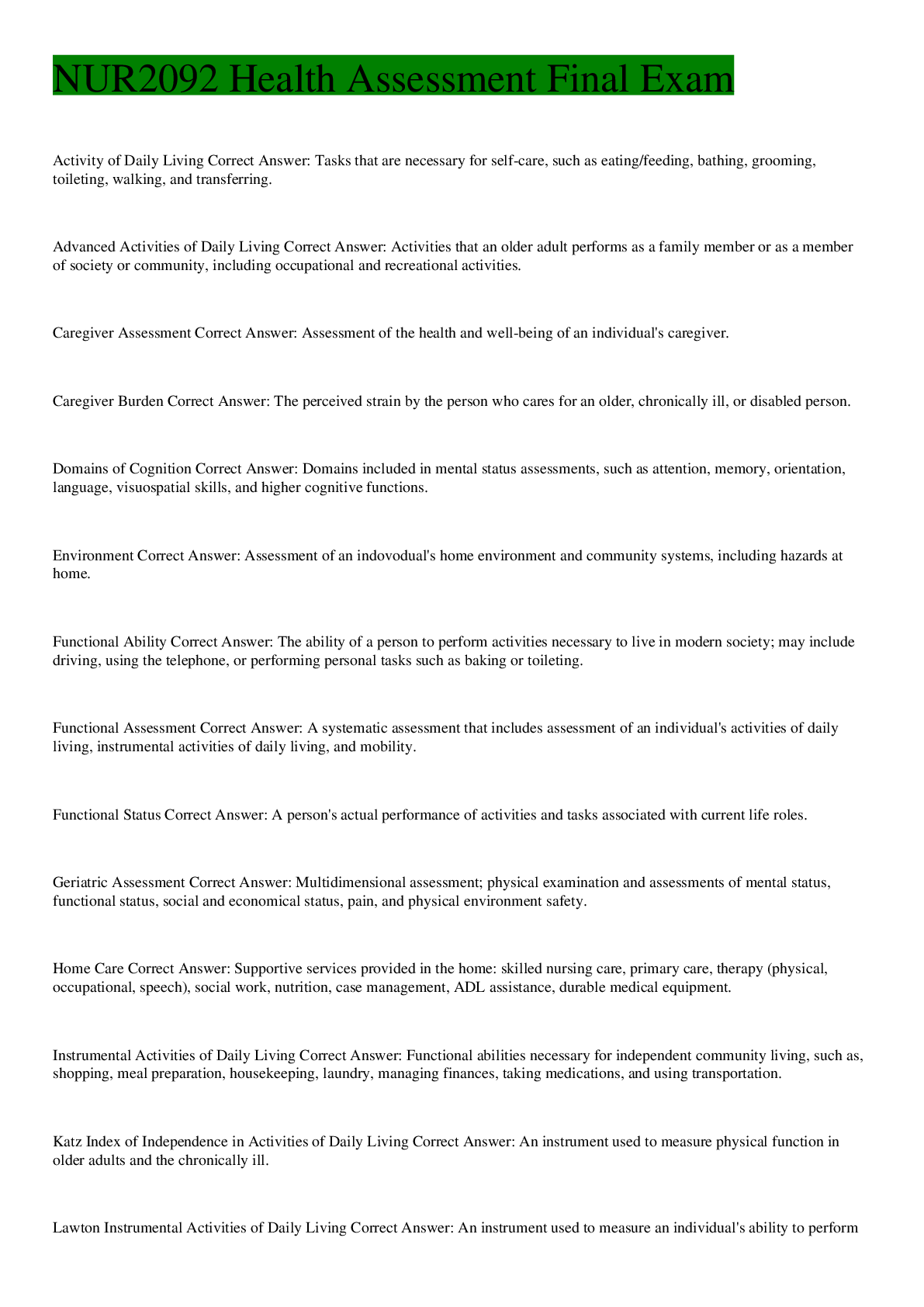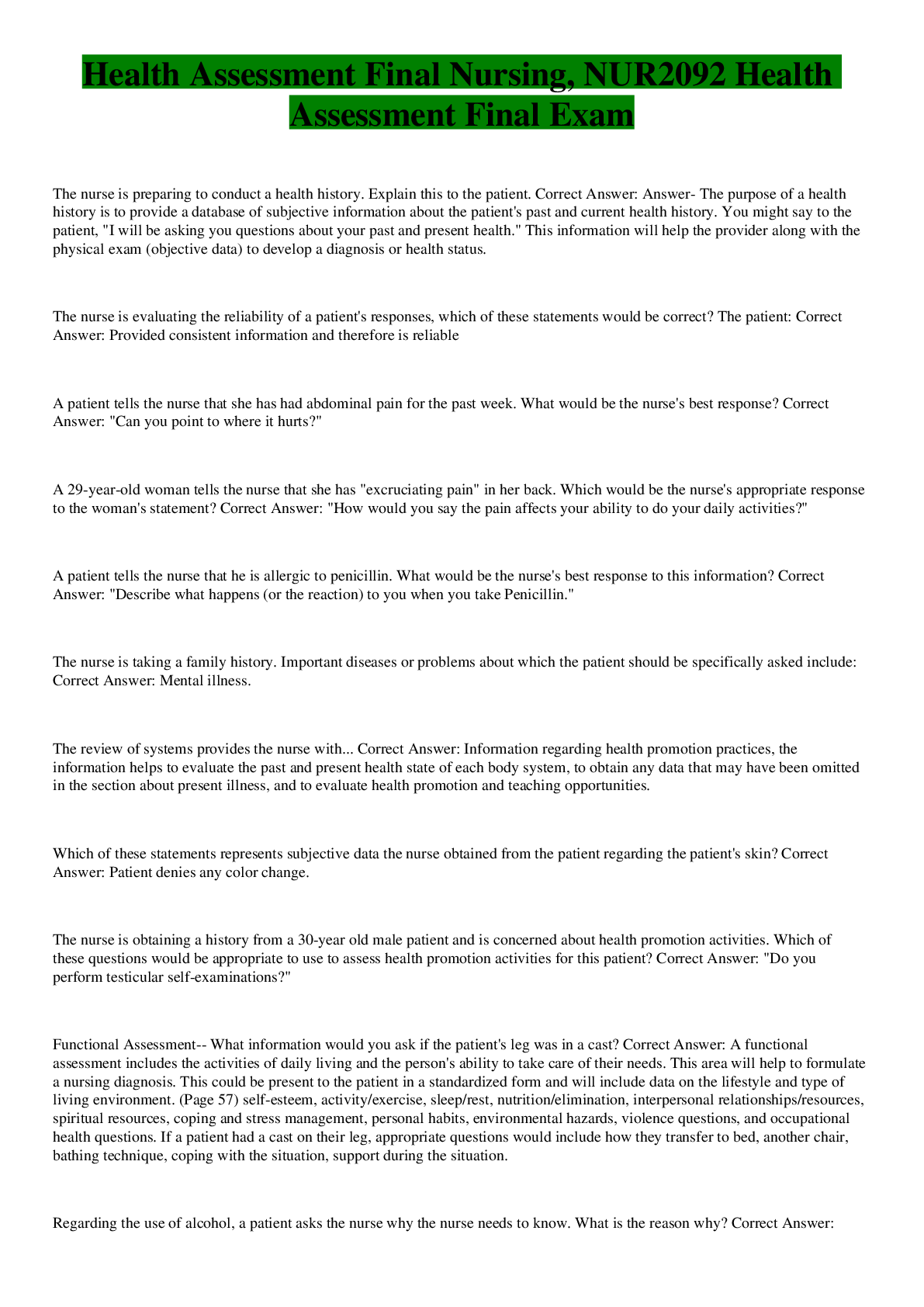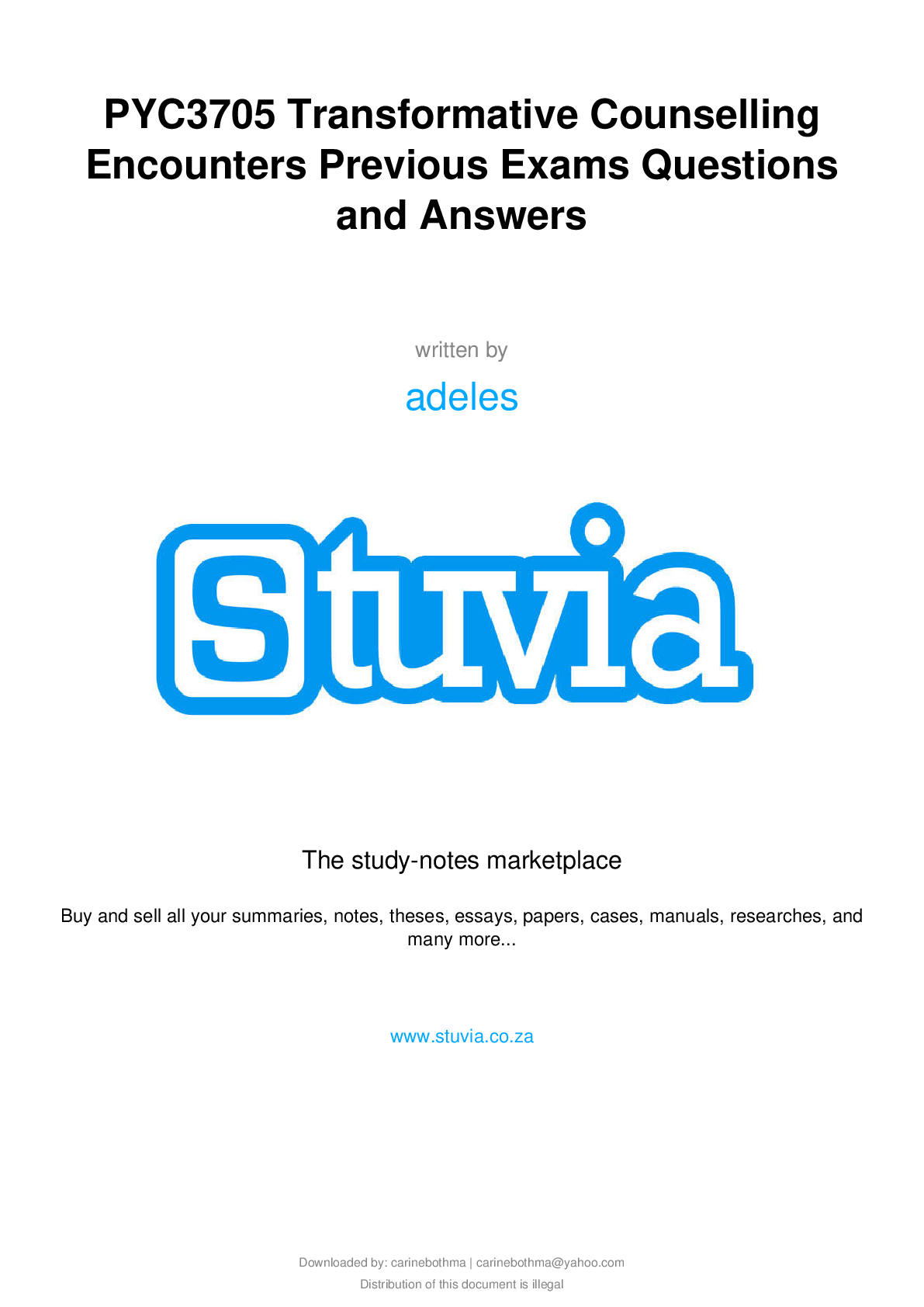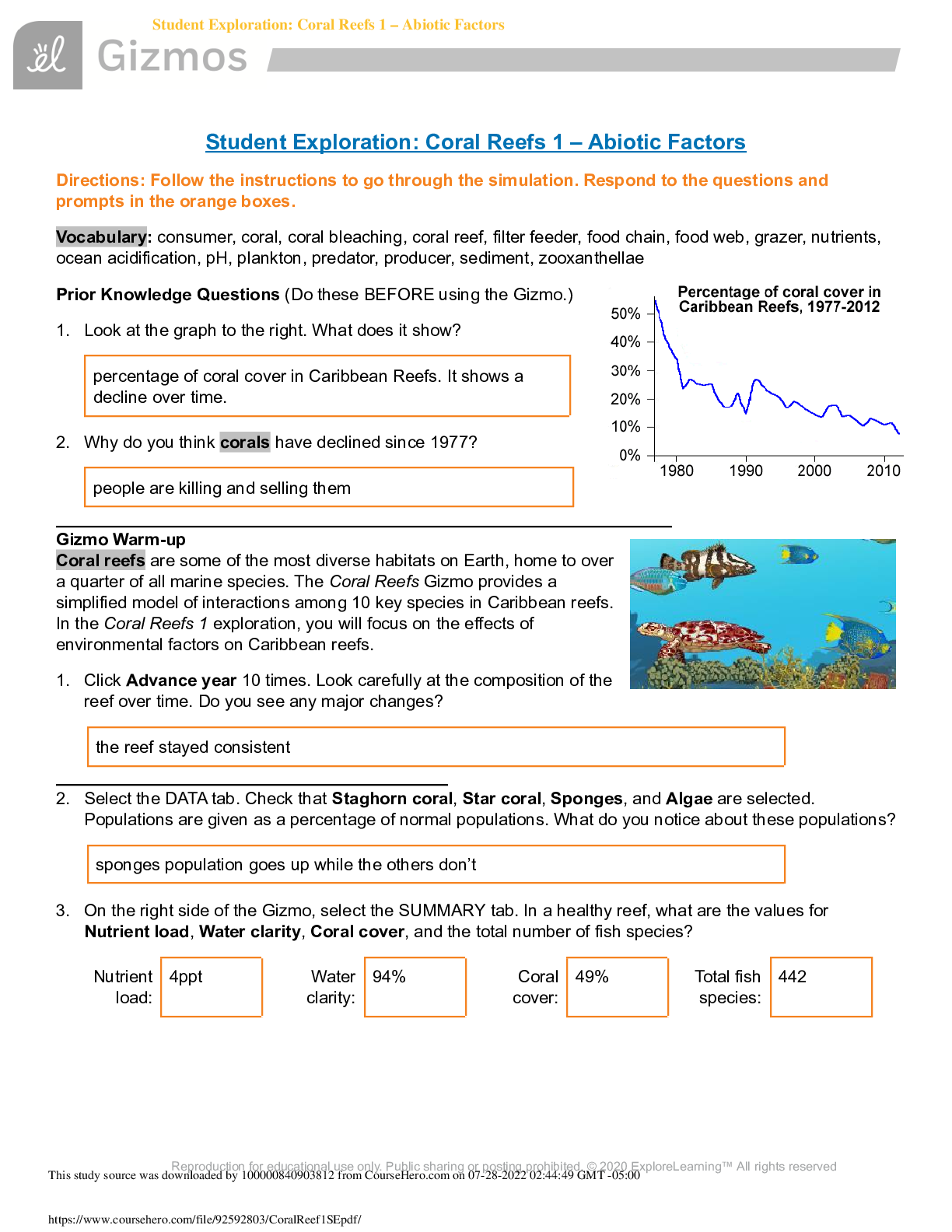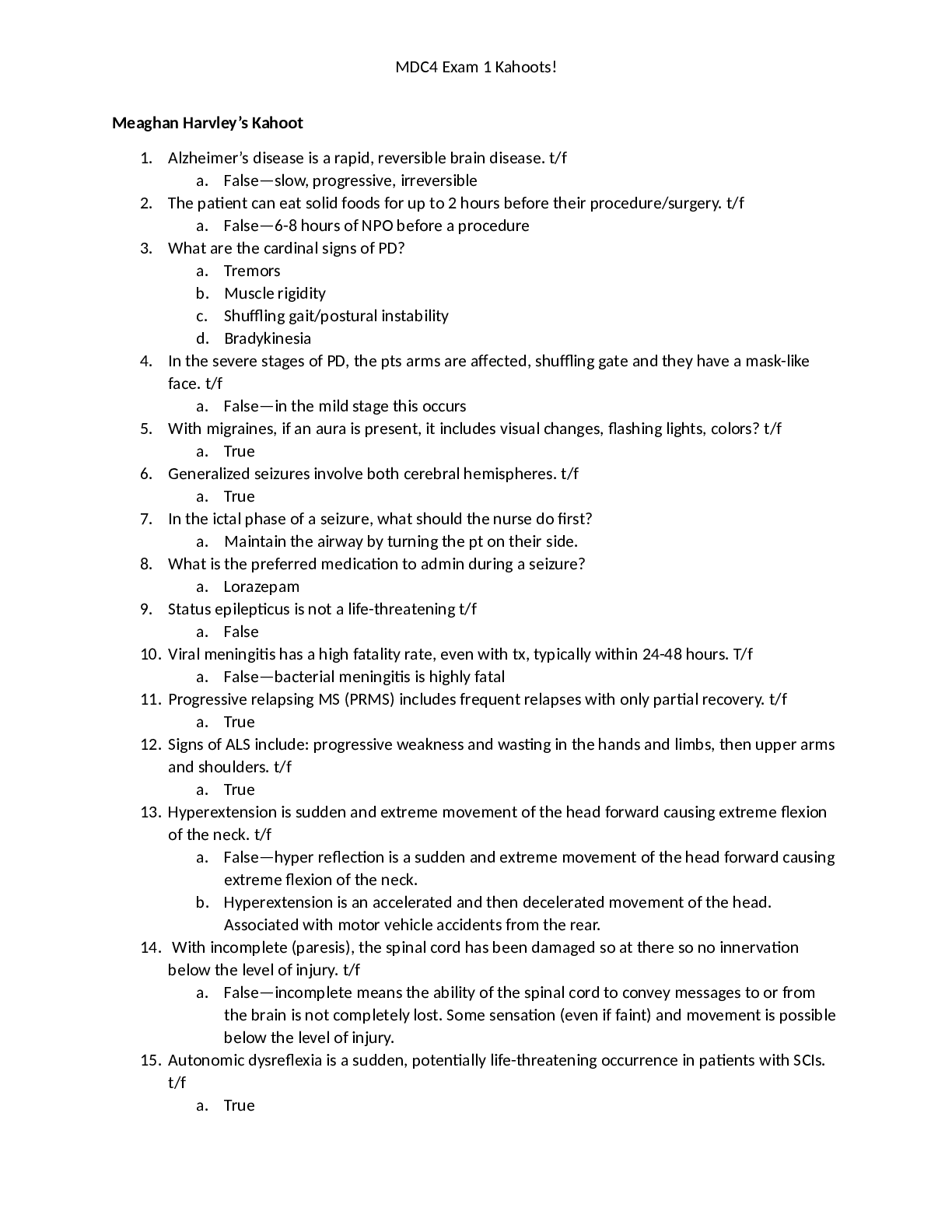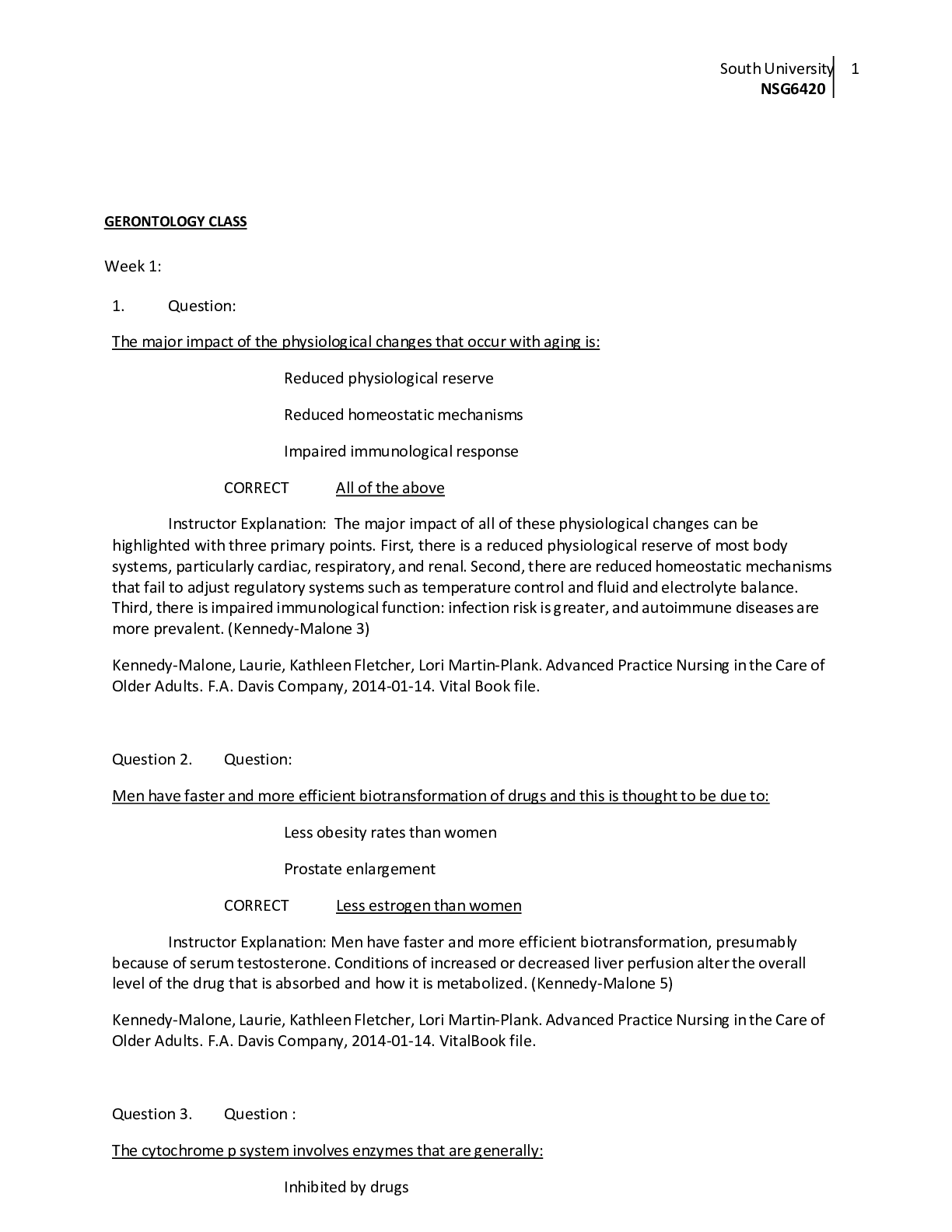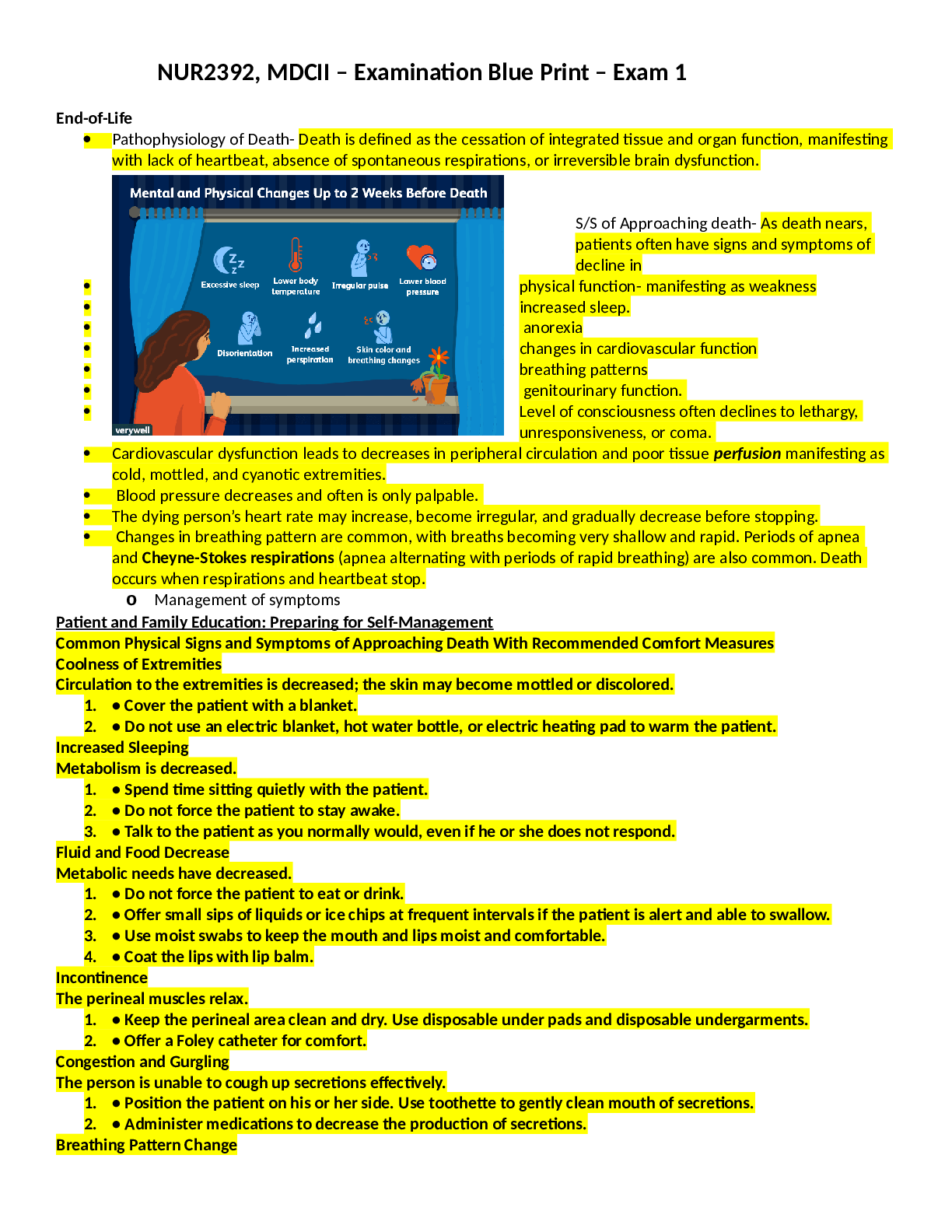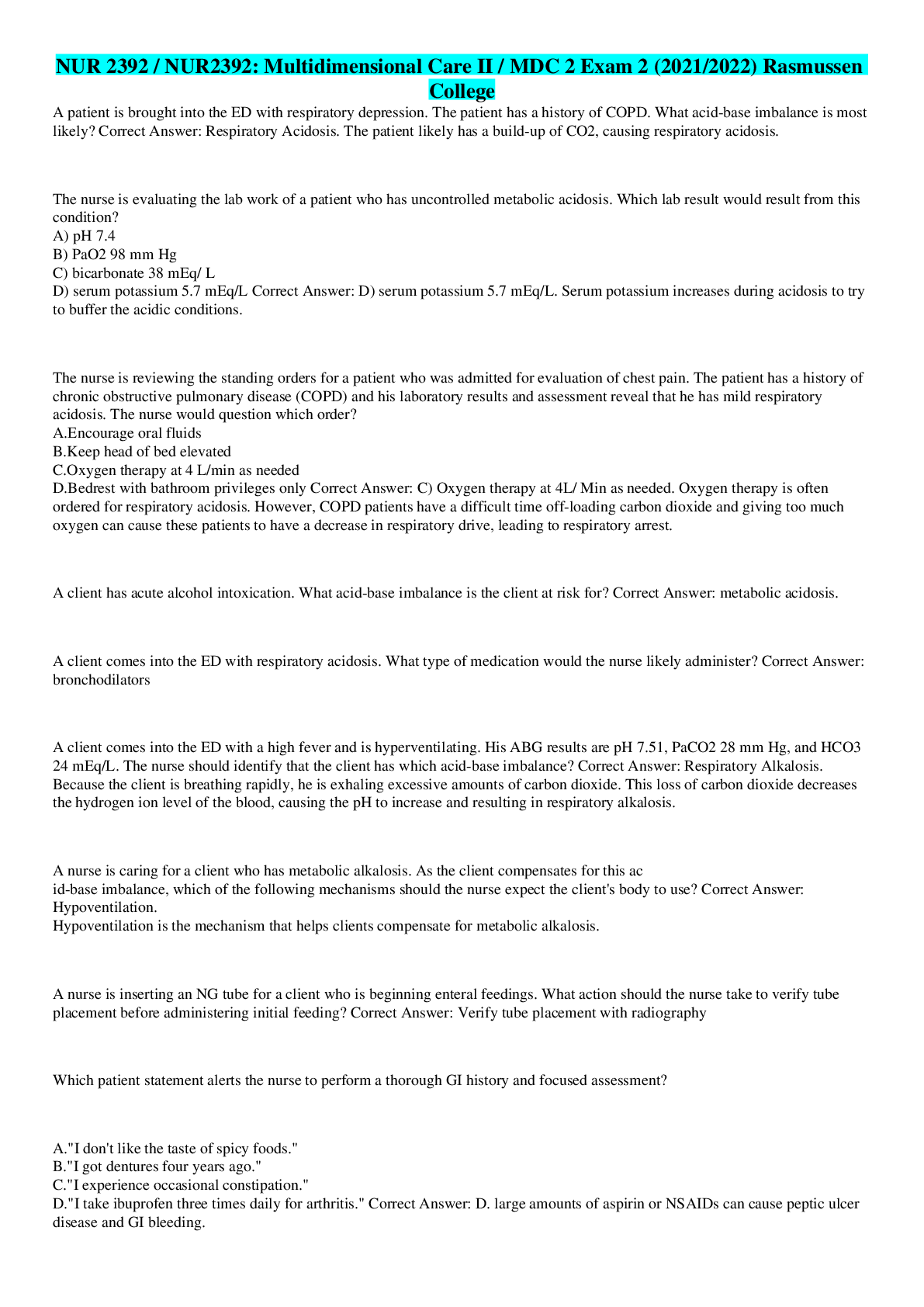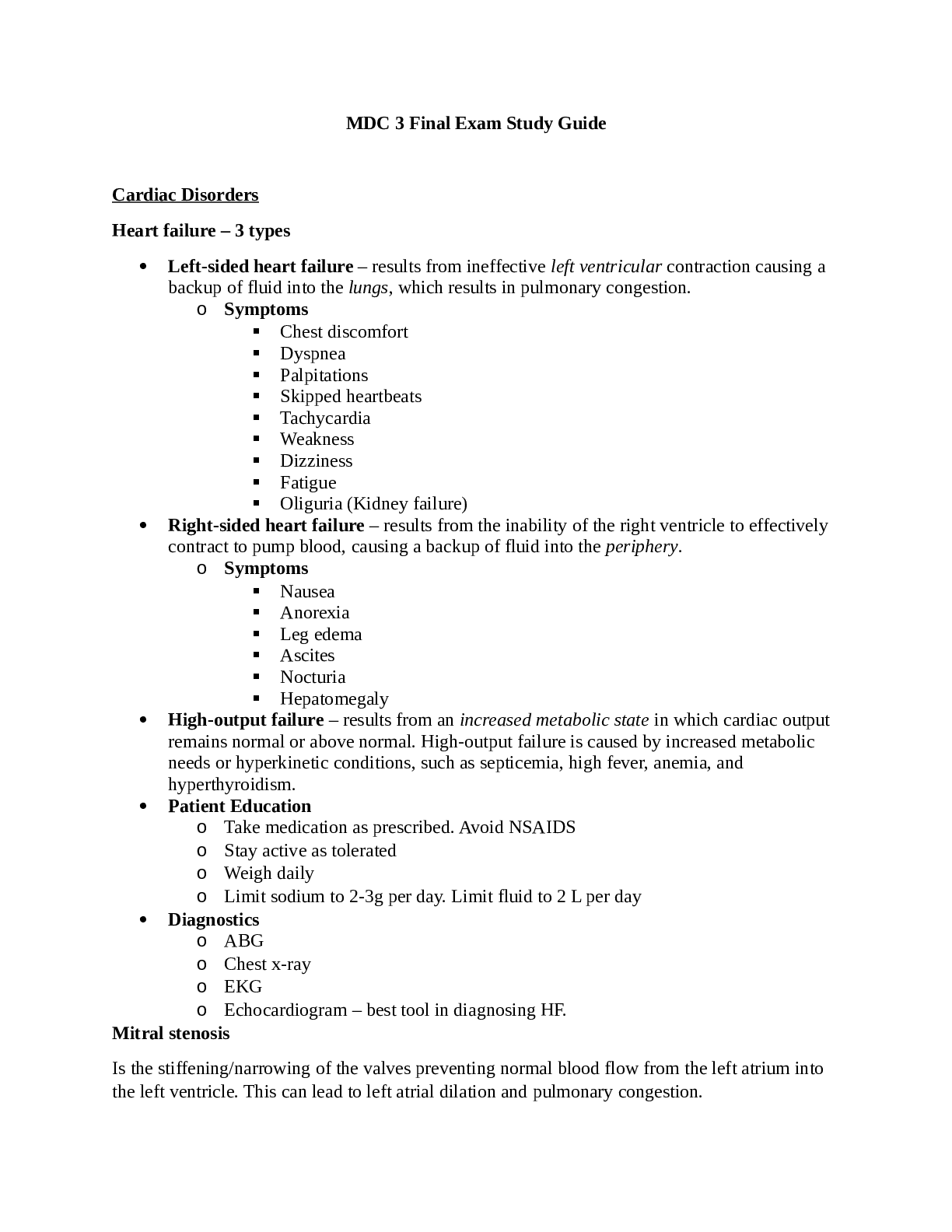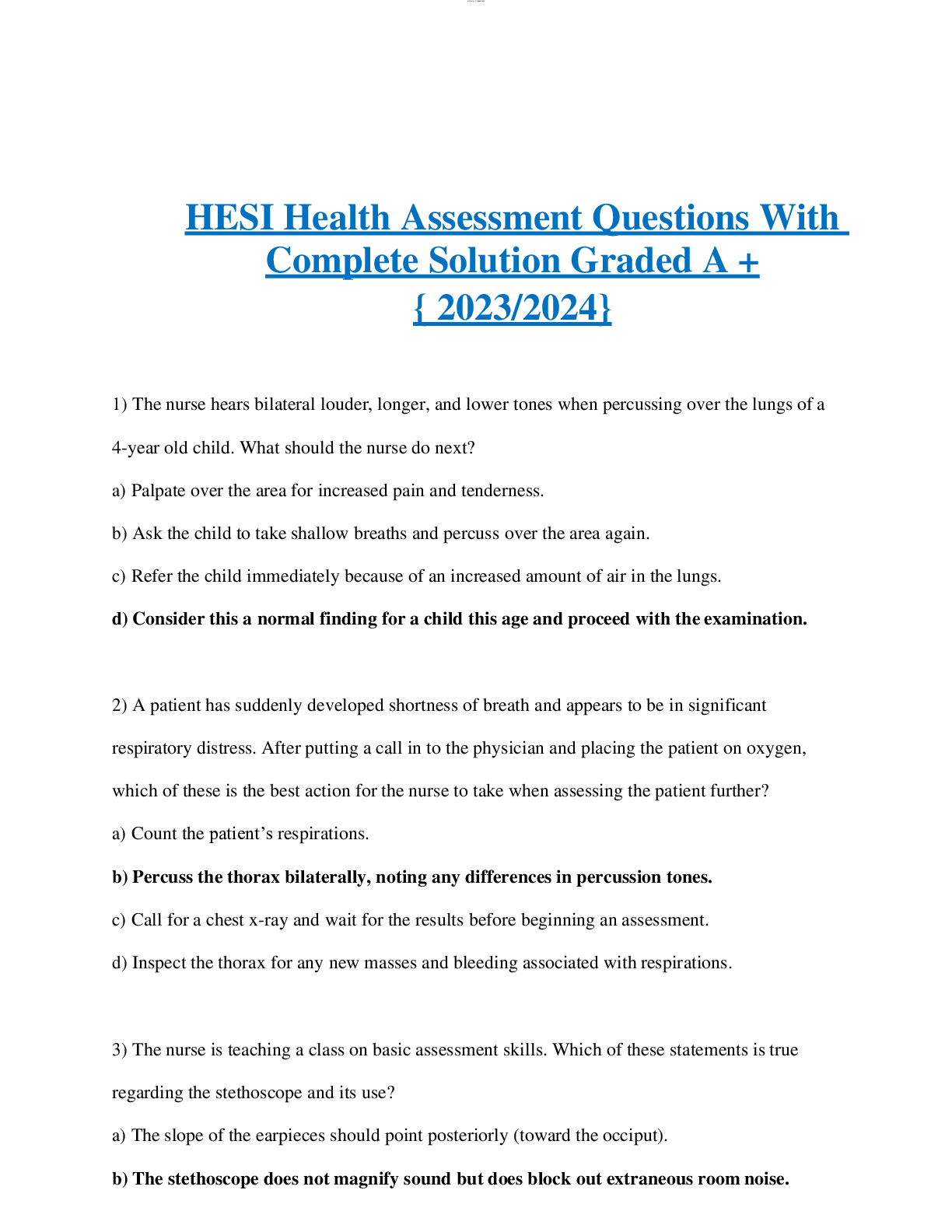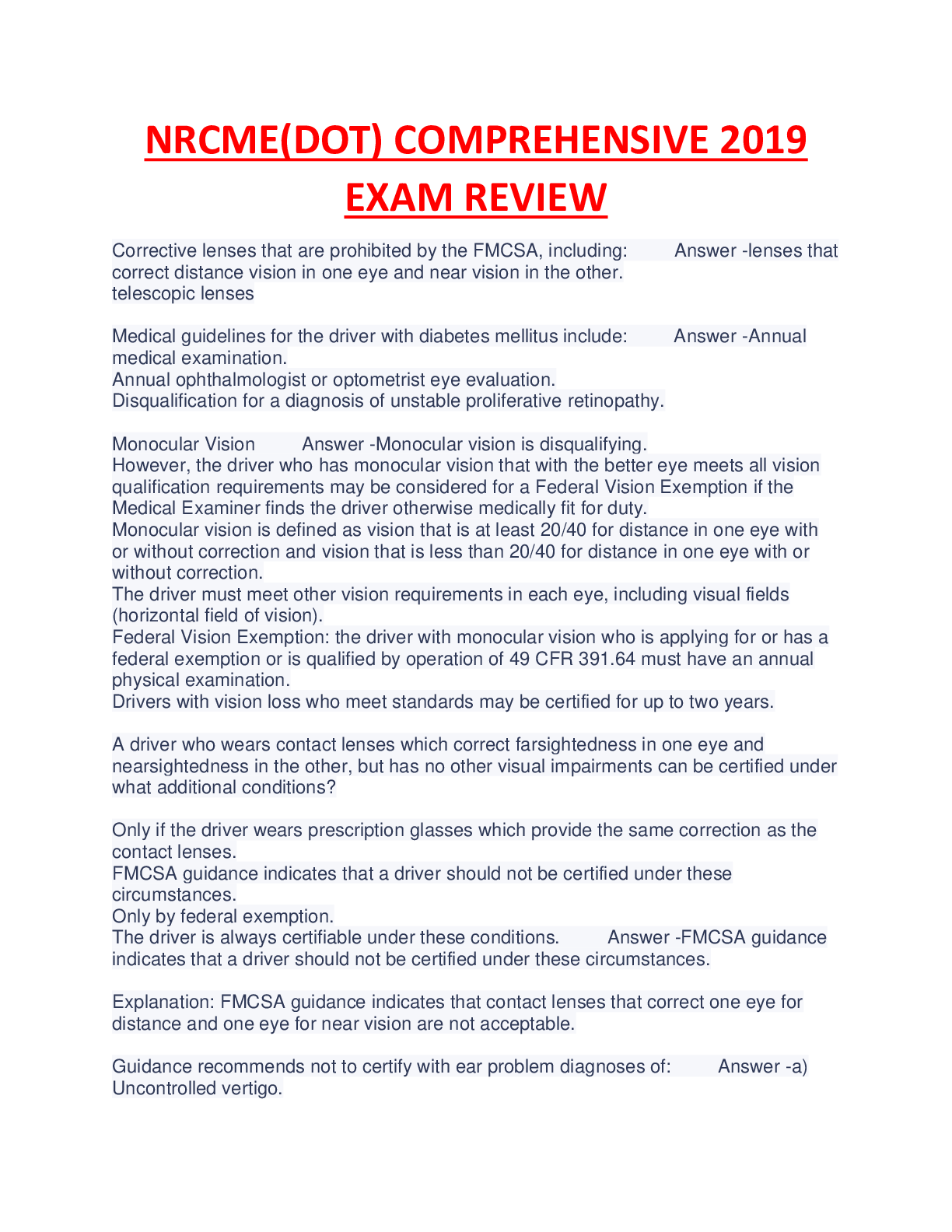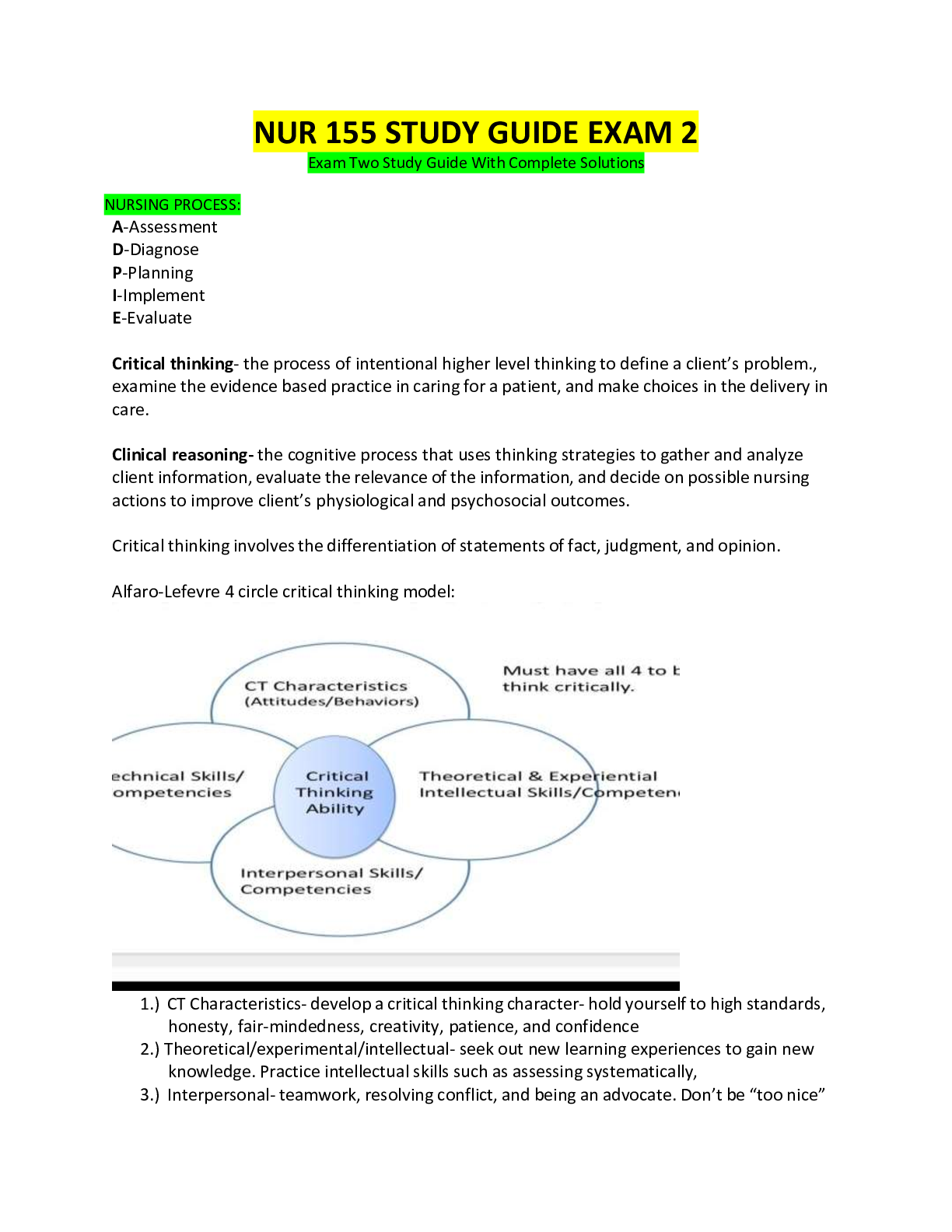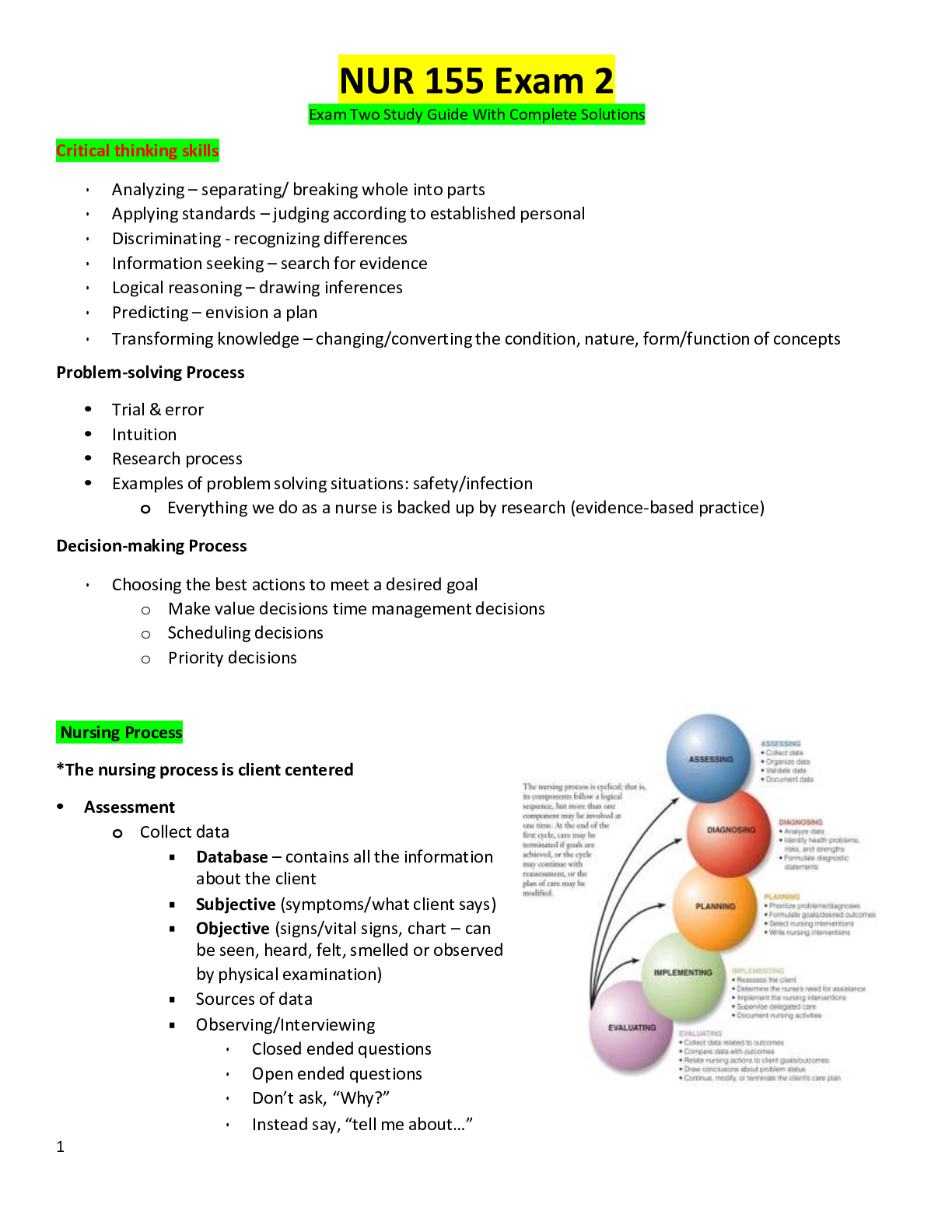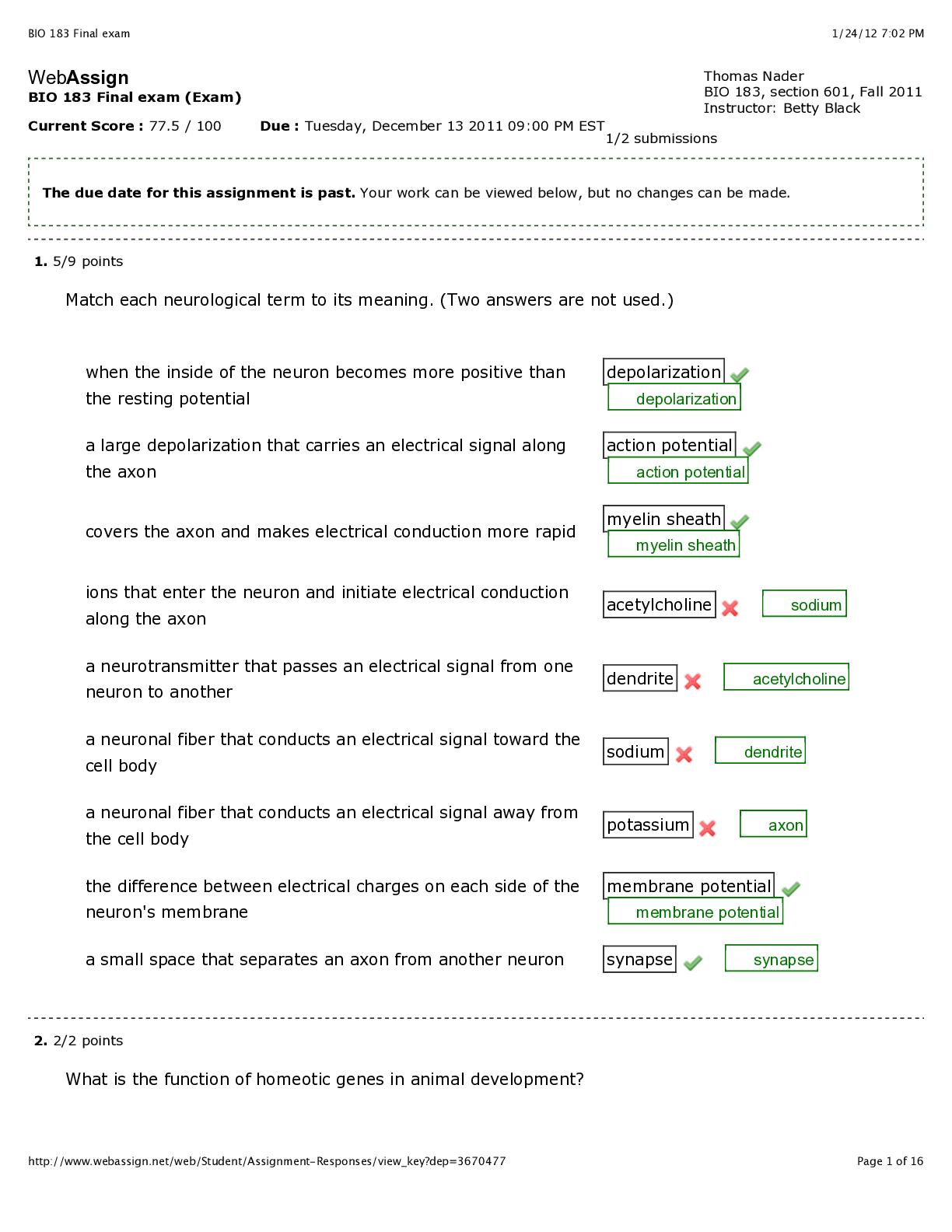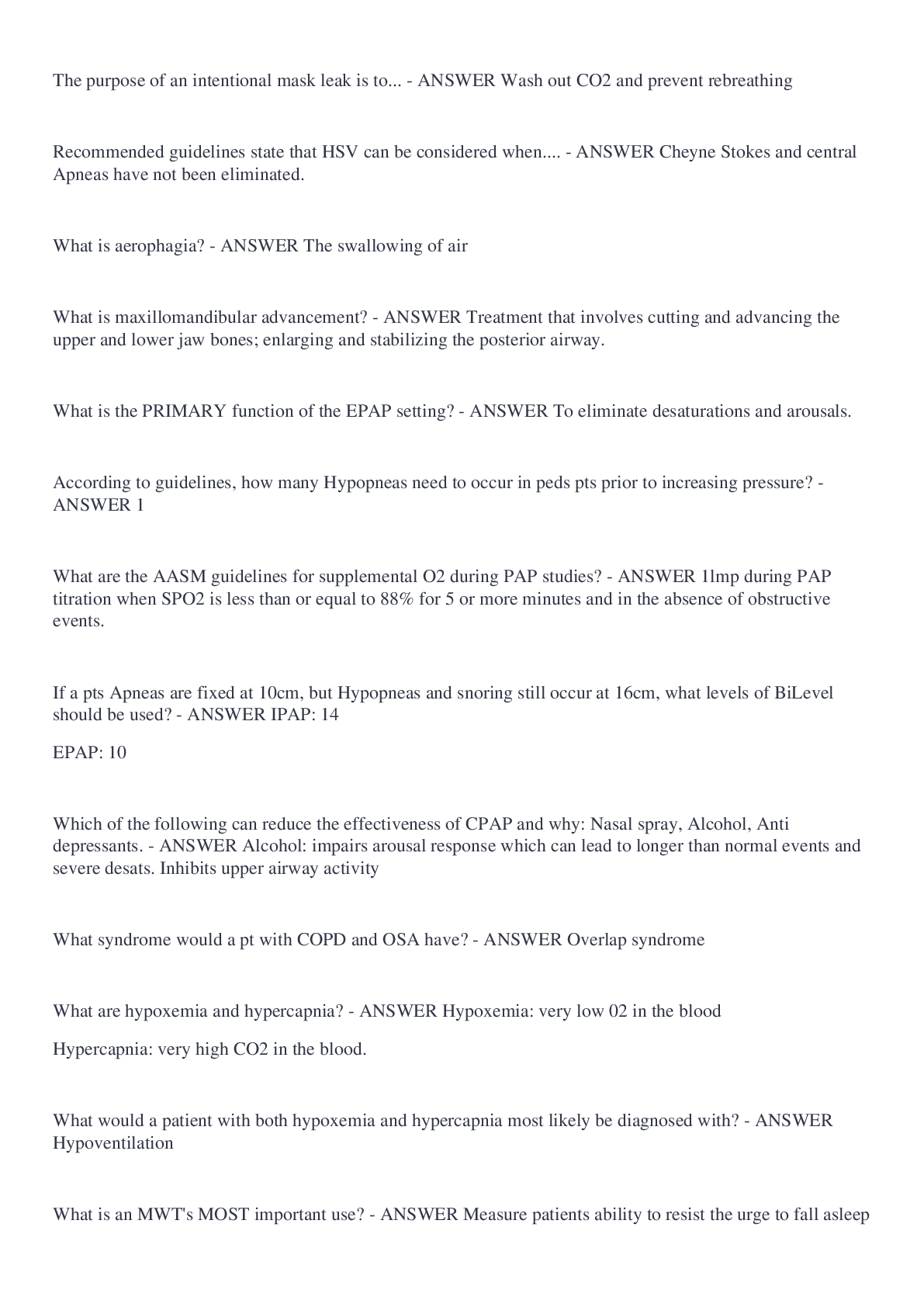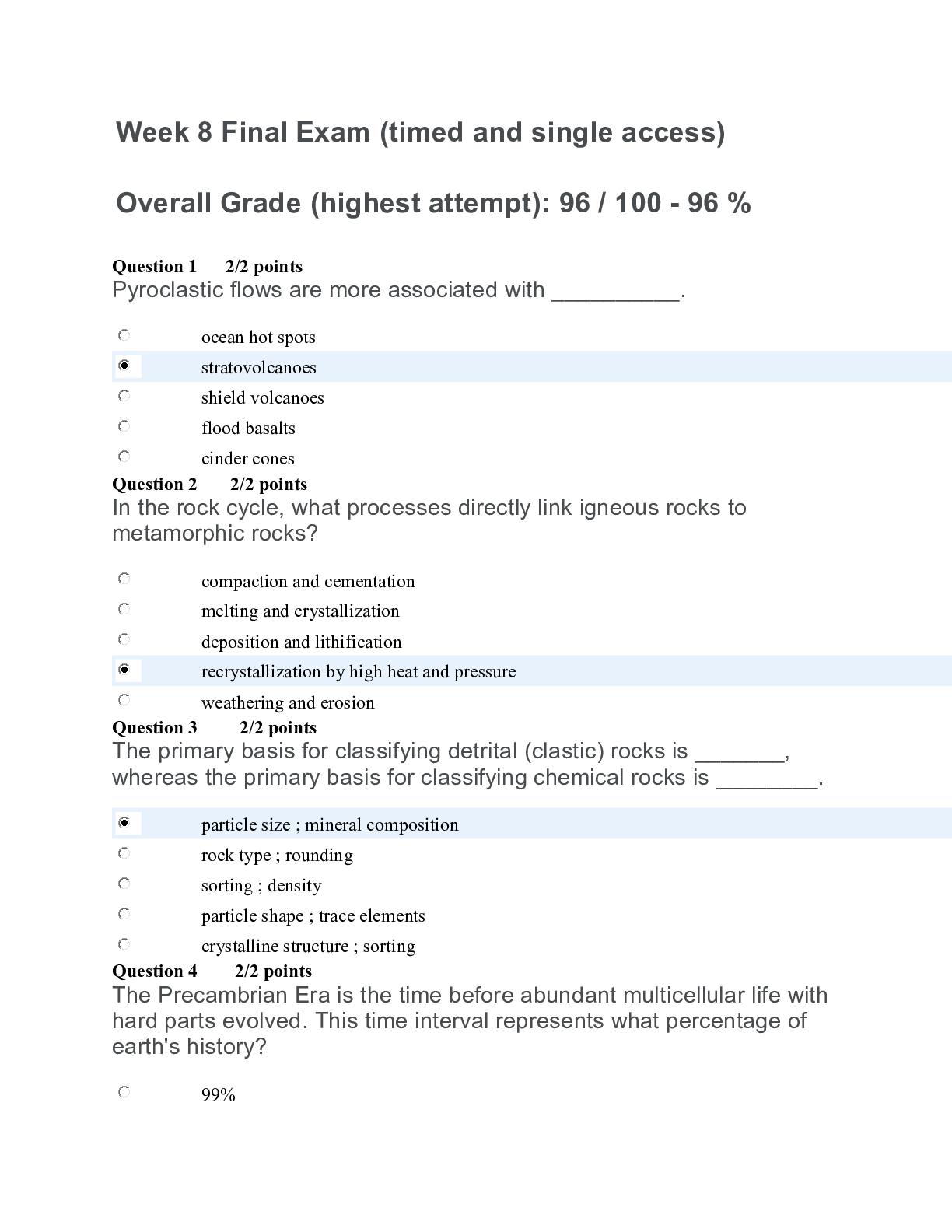Health Care > EXAM > SLP ETS Practice Test 2022/2023 Form 3 QUESTIONS WITH COMPLETE SOLUTIONS (All)
SLP ETS Practice Test 2022/2023 Form 3 QUESTIONS WITH COMPLETE SOLUTIONS
Document Content and Description Below
SLP ETS Practice Test 2022/2023 Form 3 An SLP works with a toddler on combining words and assessing a variety of semantic relations. Match each toddler utterance with the semantic relation it bes... t reflects. Agent + Action Action + Object Attribute + Entity Recurrence Match with: =Big Cookie =Doggie eat =More cookie =Eat cookie Correct Answer: Agent + Action = Doggie eat Action + Object = Eat cookie Attribute + Entity = Big Cookie Recurrence = More cookie As part of a routine preschool screening, an SLP tests a 4 year old whose speech is characterized by *sound omissions, hypernasality, nasal emission, and weak consonants.* Which of the following would be most appropriately evaluated initially? A.Oral-motor behavior B.Velopharyngeal function C.Laryngeal function D.Phonological awareness Correct Answer: B.Velopharyngeal function The characteristics described are consistent with a resonance disorder, hence velopharyngeal function would be evaluated initially. Which of the following is the minimal contrast approach most appropriately used to treat? A.Phonological disorders B.Dysphagia C.Dysarthria D.Global aphasia Correct Answer: A.Phonological disorders Minimal contrast approach was one of the first approaches designed to adhere to phonological principles of intervention. Alicia is a fourth-grade student with a language impairment that interferes with her academic performance and social communication. On a standardized test of expressive language ability, she received an overall score of 97.5, placing her in the 65thsixty fifth percentile. Alicia's test result indicates that she A.performed as well as or better than 65% of the individuals on whom the norms were developed B.responded correctly to 65% of the 150 items included in the expressive-language test C.performed as well as or better than 65% of the other fourth graders who took the same test D.responded correctly to 97.5% of the test items, as did 65% of the other children taking the test Correct Answer: A.performed as well as or better than 65% of the individuals on whom the norms were developed Percentile rank is the percentage of the scores within the norm range that are equal to or lower than the score gained by the student. Which THREE of the following variables are considered risk factors for late language emergence? A.Male gender B.Access to print material C.Low socioeconomic status D.Moderately low birth weight E.Exposure to rich and varied vocabulary Correct Answer: Options (A), (C), and (D) are correct. Being of male gender is a risk factor cited by both ASHA and researchers for late-talking toddlers. Having a low SES is considered a risk factor by ASHA and researchers for late talking. Finally low birth weight is a risk factor as well. During a trip to the grocery store, a three-year-old boy with delayed language points to an apple on the floor and says to his mother, "Apple." The boy's mother says, "Yes, that's a big, shiny apple." Based on the mother's response, which of the following language stimulation techniques is she using? A.Imitation B.Parallel talk C.Think aloud D.Expansion Correct Answer: D.Expansion Option (D) is correct. Expansion is a method that entails providing a subject a more complex speech model but does not directly stimulate another response from the subject. An SLP works with a 4-year-old patient diagnosed with autism spectrum disorder. The patient is nonverbal, does not have a functional communication system, and does not follow simple directions. Which of the following communicative target goals is most appropriate for the SLP to prioritize for the patient? A.Matching identical pictures in an array of pictures B.Requesting wants in any modality C.Labeling of common items verbally D.Imitating a sequence of two actions Correct Answer: B.Requesting wants in any modality Option (B) is correct. Requests (mands) are very important for the early development of language and for day-to-day verbal interactions with others. Requests (mands) are usually the first type of communication acquired by an infant. A 75-year-old patient with a history of chronic obstructive pulmonary disease underwent a three-vessel coronary artery bypass graft surgery. The patient needed to be intubated for three days following surgery. After extubation, the medical team requested a swallow consultation to determine if it was safe for the patient to take oral medications and initiate oral nutrition. Based on the patient's condition, which of the following assessment procedures is most appropriate for an SLP to practice? A.Administering a clinical bedside swallow evaluation and recommending an oral diet as there were no clinical signs or symptoms of aspiration during the evaluation B.Deferring the evaluation for 24 hours because the patient was just extubated to allow a possible improvement in the patient's swallow function before evaluation C.Completing a clinical bedside swallow evaluation to determine patient readiness for an instrumental evaluation and then completing the instrumental evaluation if the patient is ready D.Determining any preexisting dysphagia with the patient and the patient's family; if there is no history of dysphagia, recommending to advance the patient's diet Correct Answer: C.Completing a clinical bedside swallow evaluation to determine patient readiness for an instrumental evaluation and then completing the instrumental evaluation if the patient is ready Option (C) is correct. Several studies using instrumental assessment have concluded that some patients recover airway protection and swallow function within 24 hours of extubation and others much later than 24 hours post-extubation following prolonged endotracheal intubation, suggesting that a 24-hour "deferral time" benchmark is not particularly useful. Which of the following procedures is most important for an SLP to consider when assessing the social aspect of a school-age child's communication skills? A.Collecting a language sample to assess narrative skills B.Assessing expressive vocabulary used by the child on a picture vocabulary test C.Observing the child interacting with peers in natural settings, such as during recess D.Looking for a discrepancy between the child's IQI Q and communication skills to determine eligibility Correct Answer: C.Observing the child interacting with peers in natural settings, such as during recess Option (C) is correct. Informal observation of a student in a natural setting is part of a comprehensive assessment. A determination of eligibility for SLP services in a school must be made from more than one source and should include authentic assessment in an informal setting. Which THREE of the following statements about this dysphagia screening test are true? *A.The screening test's sensitivity is 90%* B.The screening test's sensitivity is 69% C.The screening test's specificity is 90% *D.The screening test's specificity is 60%* *E.The number of false negatives was 5* F.The number of false negatives was 20 Options (A), (D), and (E) are correct. The screening test's sensitivity is the proportion of patients who aspirated and failed the screen (top cell in the first column) to the total of all patients who aspirated on the VFSS (total of the first column); therefore, 45/50 = 0.9045 divided by 50, equals 0.90. The screening test's specificity is the proportion of patients who did not aspirate and passed the screen (bottom cell in the second column) to the total of all patients who did not aspirate on the VFSS (total of second column); therefore, 30/50 = 0.6030 divided by 50, equals 0.60. False negatives are patients who passed the screen who actually aspirated on the VFSS (bottom cell of first column). Correct Answer: A study is conducted to determine how well a dysphagia screening test predicts aspiration that is later confirmed with a videofluoroscopic swallow study (VFSS). The study results are presented in the table below. Options (A) and (D) are correct. The screening test's sensitivity is the proportion of patients who aspirated and failed the screen (top cell in the first column) to the total of all patients who aspirated (total of the first column). The screening test's specificity is the proportion of patients who did not aspirate and passed the screen (bottom cell in the second column) to the total of all patients who did not aspirate on the VFSS (total of second column). Correct Answer: A study is conducted to determine how well a dysphagia screening test predicts aspiration that is later confirmed with a videofluoroscopic swallow study (VFSS). The study results are presented in the table below. Which TWO of the following statements about the results of a screening test are correct? A.Sensitivity is the proportion of people who fail the screening test who are aspirators B.Specificity is the proportion of people who pass the screening test who are aspirators C.Sensitivity is the proportion of people who pass the screening test who are not aspirators D.Specificity is the proportion of people who pass the screening test who are not aspirators During a speech-language evaluation at a preschool, a child has difficulty with receptive language tasks and responds with only one-word utterances to expressive language items. The child's eye contact is poor throughout the session. When observed with the other children in class, the child does not engage with peers but prefers self-stimulating behaviors such as flapping arms and throwing papers up in the air. According to the child's teacher, these are typical behaviors for the child. Given the data obtained, which of the following steps is most appropriate for the SLP to take next? A.Engaging in an interprofessional practice (IPP) to determine the appropriate diagnosis of ASD B.Conducting the full evaluation when the child is more cooperative so that accurate recommendations can be made C.Initiating expressive language therapy to focus on expanding conversational utterances D.Training the teacher to deliver language stimulation tasks because the child does not respond well to the SLP Correct Answer: Option (A) is correct. Although it is in the SLP's scope of practice to diagnose ASD, it is stated that best practice suggests a team approach when making this determination. Christel and Sharon are 14-month-old fraternal twins. Christel has more intelligible words than her sister, although she talks far less frequently. Sharon speaks almost exclusively in running jargon that nobody understands. Their parents are worried about Sharon's development because her language skills appear to be behind those of her sister. Which of the following is an SLP''s best response to the parents' concern? A.At Sharon's age, jargon is normal and may even continue for another three to four months. B.Christel's language development is more abnormal because she should be beyond single words. C.Both girls were exposed to the same language environments, so the relative lack of intelligible words indicates a language delay. D.Jargon should not persist past the age of 12 months and thus Sharon may be presenting a language disorder. Correct Answer: Option (A) is correct. Jargon typically continues until around 18 months of age. An SLP engages in interprofessional practice in a large health care center and works with a neurologic rehabilitation team to treat a patient who is status post left-hemisphere stroke. The SLP's primary focus on the team is to A.lead the interdisciplinary team to improve patient care B.reduce costs and the number of professionals working at the site C.obtain licenses in multiple areas of practice to engage in a range of services D.improve the patient experience and outcome of care at the site Correct Answer: Option (D) is correct. The primary goal of interprofessional practice is to improve patient care. Which of the following communication diagnoses would most likely require a treatment program that is focused on improving auditory language comprehension? A.Right-hemisphere communication impairment B.Global aphasia C.Wernicke's aphasia D.Broca's aphasia Correct Answer: Option (C) is correct. The hallmark of Wernicke's aphasia is deficits in auditory comprehension, because the site of lesions is most typically the left superior temporal gyrus. Which of the following procedures best establishes whether velopharyngeal dysfunction causing hypernasality is present in a patient with flaccid dysarthria? A.A nasopharyngoscopy B.A videofluoroscopic swallow study C.A laryngoscopy D.A manometry Correct Answer: Option (A) is correct. Nasopharyngoscopy is the only procedure that allows visualization of the velopharyngeal port during speech. The parents of an 8-year-old boy who stutters are upset because their child was placed in the lowest reading group at school because of his poor performance on an oral reading fluency assessment in the classroom. The parents are very sure that their child is reading at an average to above-average level compared to his classmates. The S L P's informal observations of the boy's reading performance during fluency therapy sessions are consistent with the parents' report. Which of the following is the most appropriate way for the SLP to advocate for the boy? A.Offer to conduct a reading assessment with the boy and report the score to the boy's teacher. B.Recommend that the teacher reassess the child's reading level with an assessment that uses silent reading. C.Wait until the child's speech improves in therapy, and then ask the child's teacher to readminister the oral reading assessment. D.Encourage the child to continue practicing oral reading to demonstrate to his teacher that individuals who stutter can read as well as other people. Correct Answer: Option (B) is correct. The boy's stuttering is affecting his fluency during oral reading, so an assessment of his silent reading fluency will provide more valid results. Which of the following conditions is primarily associated with a short lingual frenulum, heart-shaped tongue tip, and a failure to elevate the tongue tip beyond the mandibular incisors, as revealed during oral-facial examination? A.Bulbar palsy B.Ankyloglossia C.Glossoptosis D.Congenital lip pits Correct Answer: Option (B) is correct. Limited tongue mobility, heart-shaped tongue tip and a failure to elevate the tongue tip beyond the mandibular incisors are all characteristics of ankyloglossia (tongue-tied/short lingual frenulum). A school district does not use a standard therapy log for SLP services. An SLP who works for the district develops a form to document therapy services provided. Which THREE of the following are key to include on the form to document the provision of speech and language IEP services? A.The date a student's IEP was established B.Student performance during the therapy session C.Names of other students in the group D.Types of services provided within a therapy session E.Signature from the SLP verifying delivery of services Correct Answer: Options (B), (D), and (E) are correct. Information on student performance is important data and helps to track progress, listing the types of services indicates what was provided, and the SLP's signature documents who provided the service. Which of the following activities is an example of a metalinguistic strategy used to assist a student with language difficulties? A.Providing a definition of a word B.Placing story elements in sequential order C.Editing the writing of same-aged peers D.Discussing similarities and differences between two pictures Correct Answer: Option (C) is correct. Editing the writing of a same-age peer is an example of a metalinguistic activity because it involves the awareness, analysis, and control of language form, content, and use. A 24-year-old male self-refers for a fluency evaluation. His presenting complaint is stuttering. During conversation at the initial assessment, he speaks intelligibly at a typical rate and produces no overt stutter-like disfluencies. He reports that he often expects to stutter while conversing, but that he usually can prevent or conceal the occurrence of the expected fluency disruptions either by substituting a word or by inserting a pause or "um" before the word upon which he expects to be disfluent. He states that these strategies are useful and that he would like to be able to "talk without thinking about talking." He reports that he attended speech therapy from elementary school through high school and that it helped him reduce disfluency significantly during therapy activities, but his disfluency frequency did not change much during activities outside of therapy. He fears that coworkers will react negatively to hearing him stutter. Consequently, he talks as little as possible at work. The patient's assessment results are most consistent with which of the following diagnoses? A.Neurogenic stuttering B.Cluttering C.Developmental stuttering D.Specific language impairment Correct Answer: Option (C) is correct. Some people who stutter can prevent anticipated instances of stutter-like disfluency either by substituting words or by delaying the start of a word upon which stuttering is anticipated, e.g., by pausing or by interjecting fillers such as "um." Speech-related fear, concern about listener evaluations, and anticipated disfluency are all hallmarks of stuttering but are not typical symptoms in SLI or cluttering. Even though the SLP has not heard stuttering-like disfluency in the patient's speech, all other symptoms are consistent with a diagnosis of stuttering. A 24-year-old male self-refers for a fluency evaluation. His presenting complaint is stuttering. During conversation at the initial assessment, he speaks intelligibly at a typical rate and produces no overt stutter-like disfluencies. He reports that he often expects to stutter while conversing, but that he usually can prevent or conceal the occurrence of the expected fluency disruptions either by substituting a word or by inserting a pause or "um" before the word upon which he expects to be disfluent. He states that these strategies are useful and that he would like to be able to "talk without thinking about talking." He reports that he attended speech therapy from elementary school through high school and that it helped him reduce disfluency significantly during therapy activities, but his disfluency frequency did not change much during activities outside of therapy. He fears that coworkers will react negatively to hearing him stutter. Consequently, he talks as little as possible at work. Which of the following approaches is the most appropriate initial therapy focus for the patient? A.Improving the naturalness of the speech B.Implementing use of the cancellation technique in conjunction with conversational disfluencies C.Improving the ability to pause at appropriate linguistic boundaries when speaking D.Reinforcing the patient's attempts to produce words without the use of fillers, pauses, or word substitutions Correct Answer: Option (D) is correct. Reinforcing open stuttering directly addresses the client's fear of stuttering and provides opportunities for the client to objectively evaluate how other people respond when he stutters openly. A 24-year-old male self-refers for a fluency evaluation. His presenting complaint is stuttering. During conversation at the initial assessment, he speaks intelligibly at a typical rate and produces no overt stutter-like disfluencies. He reports that he often expects to stutter while conversing, but that he usually can prevent or conceal the occurrence of the expected fluency disruptions either by substituting a word or by inserting a pause or "um" before the word upon which he expects to be disfluent. He states that these strategies are useful and that he would like to be able to "talk without thinking about talking." He reports that he attended speech therapy from elementary school through high school and that it helped him reduce disfluency significantly during therapy activities, but his disfluency frequency did not change much during activities outside of therapy. He fears that coworkers will react negatively to hearing him stutter. Consequently, he talks as little as possible at work. Which of the following approaches would be the most direct way to address the patient's fear of how coworkers might react to his disfluent speech? A.Application of principles from cognitive behavioral therapy B.Fluency-shaping therapy based on prolonged speech C.Pharmacological management D.Application of progressive relaxation therapy principles Correct Answer: Option (A) is correct. Research supports the idea that Cognitive Behavioral Therapy (CBT) can change the communication-related attitudes of people who stutter. Which of the following nerves provides efferent innervation to the stylopharyngeus muscle and contributes toward the elevation of the pharynx and the larynx? A.The trigeminal B.The hypoglossal C.The vagus D.The glossopharyngeal Correct Answer: Option (D) is correct. The functions described are controlled by cranial nerve IX9, the glossopharyngeal. A patient presents to a speech-language pathologist with voice changes. After completing a patient assessment, the SLP notes that the patient's vocal quality and function indicate the possibility of a superior laryngeal nerve injury. Which of the following presentations is most consistent with this impression? A.Inspiratory stridor B.Hypernasal resonance C.Complete aphonia D.Reduced pitch range Correct Answer: Option (D) is correct. The superior laryngeal nerve controls the cricoarytenoid muscles, which lengthen the vocal folds for pitch elevation. Injury to this nerve can result in reduced pitch range, particularly in the higher frequency range. Kimberly, a patient who suffered a brain stem stroke and has had a fairly successful recovery, complained of food sticking in her throat and needing to swallow two to three times to clear liquid and solid boluses. She underwent a videofluoroscopic swallowing study that showed a limited duration of upper esophageal sphincter opening. The SLP decides to employ an intervention plan that includes the Mendelsohn maneuver. Which of the following strategies is most likely to be effective in accomplishing this goal? A.Completing a fiberoptic endoscopic evaluation of swallowing (FEES) to determine if the patient is performing the maneuver properly B.Performing cervical auscultation (CA) to quantify improved swallowing with the maneuver C.Using submental surface electromyography (sEMG) as biofeedback during attempts to perform the maneuver D.Teaching the patient to use palpation of her neck and a mirror to help her master the maneuver Correct Answer: Option (C) is correct. Submental surface EMG has been shown to improve acquisition of the Mendelsohn maneuver in some people though the maneuver itself is very difficult to learn. Which of the following statements accurately describes state licensure requirements that must be met for an SLP to legally provide services via telepractice within the state or across state lines? A.An SLP is required to hold a specialty certification to provide services via telepractice because this service delivery method requires additional skills. B.No state licensure requirements apply to individual SLPs providing services via telepractice, as long as their employers can obtain reimbursement. C.The SLP should check with all relevant state licensure boards before delivering telepractice services. D.As long as the SLP has the ASHA Certificate of Clinical Competence and is licensed in the SLP's state of residence, the SLP can legally provide services via telepractice anywhere. Correct Answer: Option (C) is correct. States differ on licensure rules regarding telepractice at this time, and failing to know the relevant regulations is not an excuse for practicing without a license. An evaluation is performed on a 5 year old with frequent hoarseness. Which of the following measures is primarily included in the endoscopic examination? A.Amplitude perturbation B.Laryngeal visualization C.Laryngeal airway resistance D.Perceptual judgment Correct Answer: Option (B) is correct. Observing the larynx is part of an endoscopic examination. According to literature on men's and women's voices, the prevalence of benign vocal fold lesions in women can best be explained by differences in A.daily dairy consumption B.speaking duration C.rates of vocal fold vibration D.neck circumference Correct Answer: Option (C) is correct. The increased fundamental frequency of most female voices results in an increased number of glottal contacts during a fixed period of voice use. This increased number of contacts is thought to increase the risk of development of benign vocal fold lesions. A child has been demonstrating significant progress in producing the targeted responses in the therapy room; however, observation in the classroom indicates little mastery of the targeted responses. Which of the following would be the most appropriate revision to the treatment plan? A.Delivering treatment in the classroom B.Increasing the frequency of treatment in the therapy room C.Increasing the duration of treatment in the therapy room D.Changing the IEP goals Correct Answer: Option (A) is correct. The child's treatment plan should now focus on generalizing the production of the targeted responses outside of the therapy room. Generalization of the targeted response must be systematic with implementation of classroom-based intervention; this revision to the therapy plan represents an integration of therapy services. During videofluoroscopic evaluation of an adult patient, the SLP notices material in both pyriform sinuses after the patient swallows. Upon review, the SLP sees that both pyriform sinuses clear during the pharyngeal swallow but then refill quickly as the structures return to rest. Which of the following statements best explains this observation? A.Pharyngeal stripping was not adequate to fully clear the pyriform sinuses, so there was material in the pyriform sinuses after each swallow. B.The patient had small pharyngeal pouches (pharyngoceles) that filled with barium during the swallow and then emptied into the pyriform sinuses after each swallow. C.Hyolaryngeal elevation was not sufficient, leaving material in the pyriform sinuses after each swallow. D.The patient had a tracheoesophageal fistula, and contrast was deposited in the pyriform sinuses after each swallow. Correct Answer: Option (B) is correct. Pharyngoceles emptying into the sinuses after each swallow could be diagnosed by analyzing slow-motion videofluoroscopic images. A child with developmental apraxia of speech is not making progress in a school setting. The parents wish to schedule additional therapy. An SLP in a local clinic evaluates and determines that a more individualized treatment plan is warranted. Which of the following actions is most appropriate for the SLP at the local clinic to take to ensure the child receives necessary treatment? A.Recommending the parents stop school treatment given the lack of progress B.Contacting the child's school SLP to coordinate treatment plans C.Encouraging private SLP treatment using a smaller group setting D.Suggesting additional treatment at the local SLP clinic using the same tasks used by the school SLP Correct Answer: Option (B) is correct. Coordinating with the school's SLPS L P potentially allows the patient the most practice of the same tasks. Which of the following risk factors has the highest independent predictive value for pneumonia in elderly people with dysphagia? A.Drinking more than six glasses of water per day B.Experiencing aspiration of saliva at night C.Depending on others for feeding and oral care D.Having a history of acute hemispheric stroke more than one year ago Correct Answer: Option (C) is correct. The landmark study done by Susan Langmore, et. aland others, showed that dependence on others for feeding and oral care was most highly correlated with pneumonia. During the course of treatment, as a child manipulates various toys in symbolic play, the clinician vocalizes the child's actions (for example, "You're putting the pan on the stove."). The intervention technique used by the clinician is identified as A.the mand model B.reauditorization C.self-talk D.parallel talk Correct Answer: Option (D) is correct. Parallel talk is a technique a clinician uses when talking aloud about what the child is seeing, hearing, or doing. A 55-year-old female presents for a speech evaluation because of concerns with recent changes in the clarity of her speech. She has also noticed occasional coughing when drinking, and her friends have commented that her voice sounds different. A recent visit to her primary care doctor could not determine the cause of her speech changes or coughing. Select the THREE most important factors for the SLP to explore during the patient interview. A.Difficulties with hearing, vision, and fine or gross motor skills B.History of a psychological or psychiatric disorder C.Employment history and current stressors in her life D.Onset and duration of her speech changes E.Consistency of the symptoms Correct Answer: Options (A), (D), and (E) are correct. This patient scenario is strongly suggestive of a late-onset or acquired neurological disorder based on the combination of speech changes across multiple subsystems and swallowing problems. In this case, the most important information for the SLP to obtain includes whether changes in other motor skills and vision and hearing accompany the changes in the duration, onset, course, and consistency of the changes in swallowing, voice, and resonance. This would help the SLP determine the most important procedures to include in the evaluation and referrals regarding the etiology of the symptoms. Which of the following statements best explains why thickened liquids for adult patients with dysphagia should be used with caution? A.Patients dislike thickened liquids and therefore do not drink enough, resulting in dehydration. B.The thickened liquid becomes thinner as it sits at the bedside, negating the liquid's benefit as a compensatory diet modification. C.Patients need twice as much thickened liquid because it provides half the hydration that thin liquid provides. D.Thickened liquids are aspirated more frequently than thin liquids. Correct Answer: Option (A) is correct. Research indicates that patients do not like thick liquids, and there is evidence that this leads to dehydration. A beginning clinician should be well aware of this and use caution when recommending thickened liquids to adult patients with dysphagia. According to the Diagnostic and Statistical Manual of Mental Disorders, Fifth Edition (DSMD) criteria for autism spectrum disorder (ASD) and social communication disorder (SCD), which of the following characteristics best helps an SLP provide a differential diagnosis for ASD instead of SCD? A.Deficits in communication appropriate for a social context B.Deficits that result in functional limitations in social participation C.Difficulty following rules for storytelling D.Repetitive and restrictive patterns of behavior Correct Answer: Option (D) is correct. Restricted and repetitive behaviors are indicative of ASD and set ASD apart from SCD. An aphasia evaluation of a 68-year-old retired woman reveals utterances of one to two words, no apraxia of speech, and relatively good comprehension. When the patient makes production errors, they are typically semantic errors and she attempts to correct them, often with success. Her goal is to use more words to convey ideas using complete sentences. She is active and wants to communicate in various settings, such as at her volunteer job, with her family, and when traveling. Which of the following treatments best prioritizes the patient's language needs and personal goals? A.Providing a script for the patient to recite that allows her to tell people about her stroke B.Starting Verb Network Strengthening Treatment (VNeST) to increase word retrieval in untrained discourse C.Engaging the patient in semantic feature analysis (SFA) to teach her self-cuing techniques and aid with word retrieval D.Having the patient use melodic intonation treatment (MIT) to increase fluency of commonly uttered phrases Correct Answer: Option (B) is correct. The patient's language impairment is related to word-retrieval impairments that affect the ability to produce complete utterances. VNeST has been shown to increase word-retrieval abilities in untrained tasks, which could potentially aid in various functional scenarios. MsMiss. Malone, a 65-year-old retired attorney, presents with severe nonfluent aphasia secondary to a stroke that occurred more than a year ago. Speech-language intervention helped her regain the ability to answer simple questions but not initiate speech. Citing MsMiss. Malone's frustration at her limitations, her family requests that she be evaluated for an augmentative and alternative communication (AAC) device. During MsMiss. Malone's assessment, the SLP determines that she could potentially benefit from AAC services and initiates discussion of intervention goals. Once goals are established and MsMiss. Malone has her device, she begins to learn how to operate her device to produce common spoken messages. Over the course of intervention, MsMiss. Malone is ultimately able to produce novel sentences. Answer the question below by clicking on the correct response. Question: Regarding MsMiss. Malone's proposed AAC assessment, which of the following statements is true? A.Her choice of devices will be severely limited by her difficulties with speech onset. B.Her family should be involved in the AAC assessment as well as any subsequent therapy. C.Given her advanced level of education, only high-tech devices should be considered. D.Given the severity of her impairment, only low-tech devices should be considered. Correct Answer: Option (B) is correct. The success of AAC intervention success is largely dependent upon the support of people close to the patient. MsMiss. Malone, a 65-year-old retired attorney, presents with severe nonfluent aphasia secondary to a stroke that occurred more than a year ago. Speech-language intervention helped her regain the ability to answer simple questions but not initiate speech. Citing MsMiss. Malone's frustration at her limitations, her family requests that she be evaluated for an augmentative and alternative communication (AAC) device. During MsMiss. Malone's assessment, the SLPS L P determines that she could potentially benefit from AAC services and initiates discussion of intervention goals. Once goals are established and MsMiss. Malone has her device, she begins to learn how to operate her device to produce common spoken messages. Over the course of intervention, MsMiss. Malone is ultimately able to produce novel sentences. Which of the following statements reflects the best strategy for the development of MsMiss. Malone's intervention goals? A.The SLP must decide which goals are appropriate, because the SLP is the communication expert. B.As the patient determines what she needs and wants to say, she must determine the goals. C.Goal setting should be a collaborative process involving the patient and the SLP. D.A number of individuals including, the patient, SLP, and close family members, should collaborate to set goals. Correct Answer: Option (D) is correct. AAC intervention works best when regular communication partners are involved along with the patient and SLP. MsMiss. Malone, a 65-year-old retired attorney, presents with severe nonfluent aphasia secondary to a stroke that occurred more than a year ago. Speech-language intervention helped her regain the ability to answer simple questions but not initiate speech. Citing MsMiss. Malone's frustration at her limitations, her family requests that she be evaluated for an augmentative and alternative communication (AAC) device. [Show More]
Last updated: 1 year ago
Preview 1 out of 43 pages
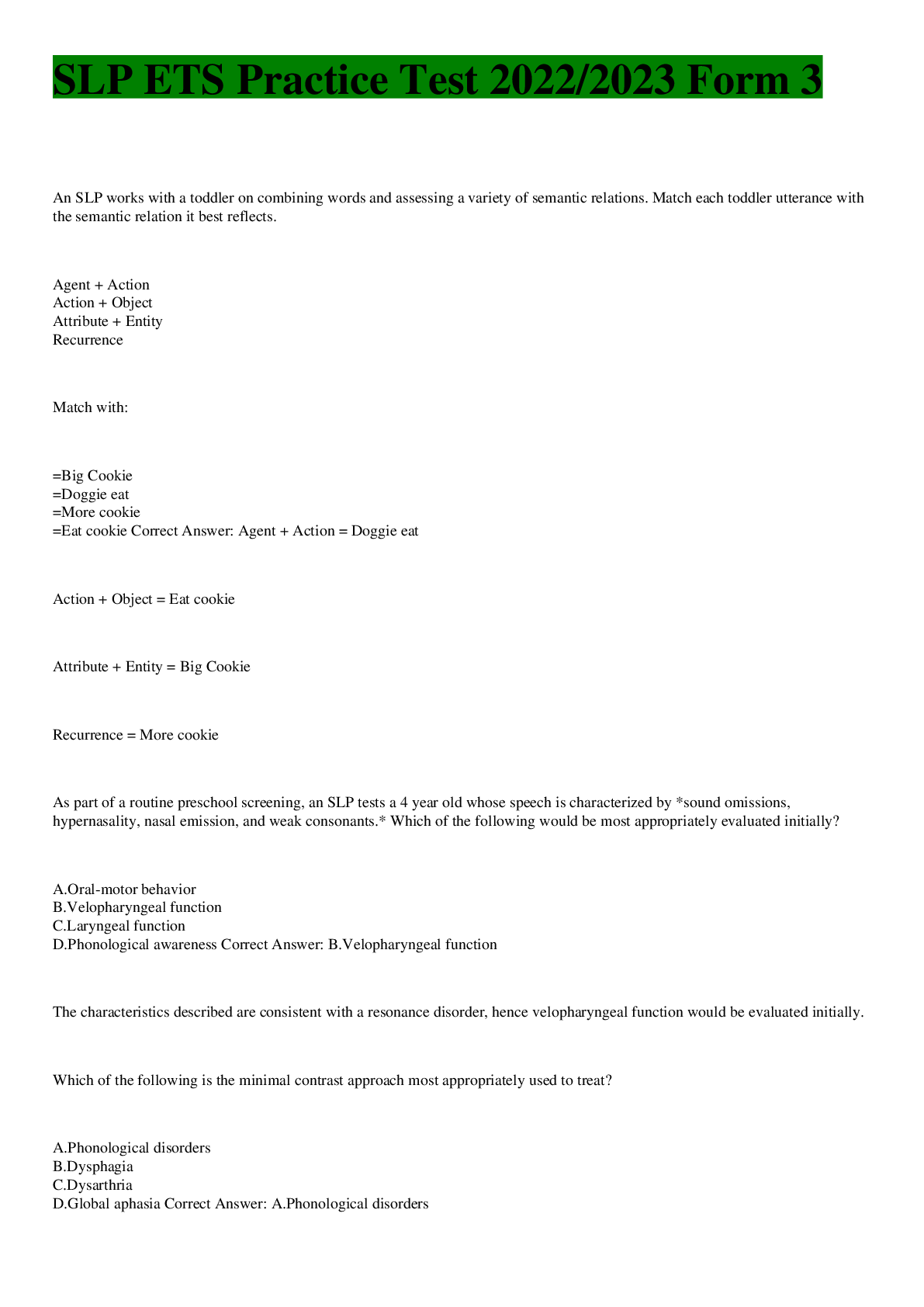
Reviews( 0 )
Document information
Connected school, study & course
About the document
Uploaded On
Jun 28, 2022
Number of pages
43
Written in
Additional information
This document has been written for:
Uploaded
Jun 28, 2022
Downloads
0
Views
39



.png)
